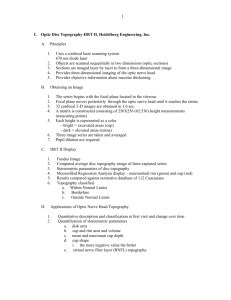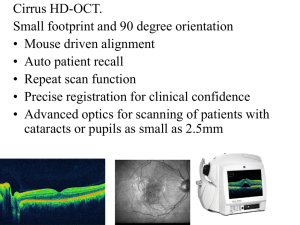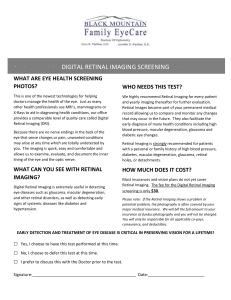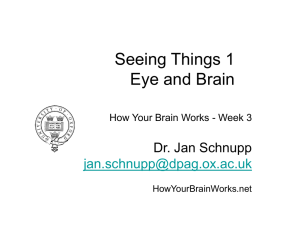Optos & OCT (2012)
advertisement
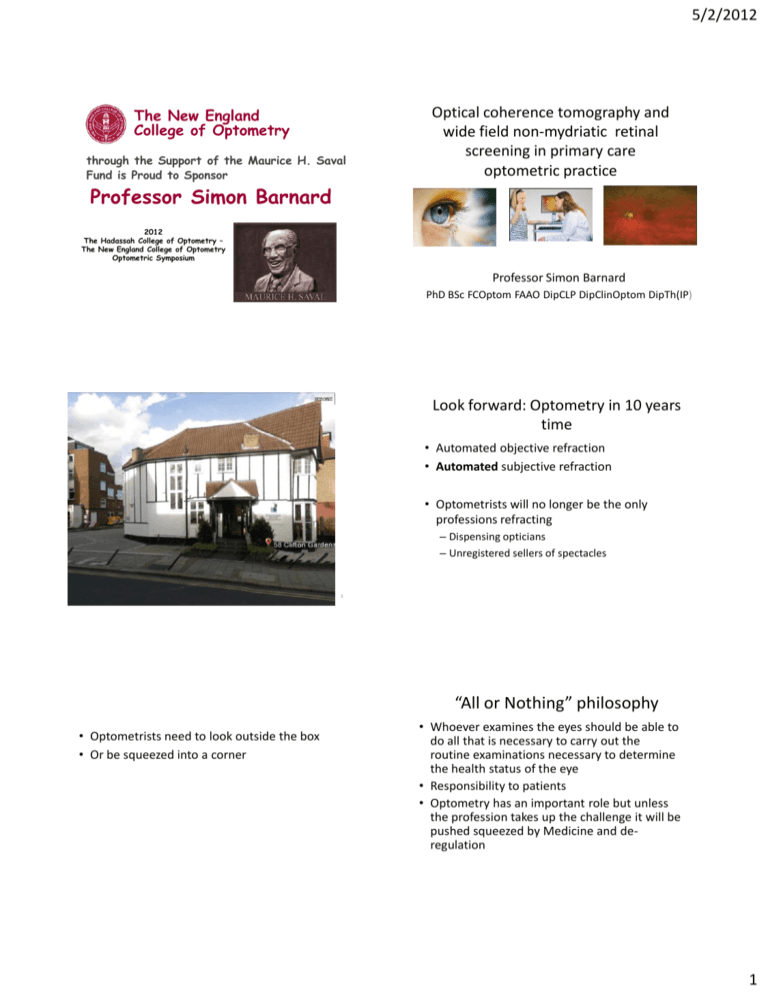
5/2/2012 The New England College of Optometry through the Support of the Maurice H. Saval Fund is Proud to Sponsor Optical coherence tomography and wide field non-mydriatic retinal screening in primary care optometric practice Professor Simon Barnard 2012 The Hadassah College of Optometry – The New England College of Optometry Optometric Symposium Professor Simon Barnard PhD BSc FCOptom FAAO DipCLP DipClinOptom DipTh(IP) Look forward: Optometry in 10 years time • Automated objective refraction • Automated subjective refraction • Optometrists will no longer be the only professions refracting – Dispensing opticians – Unregistered sellers of spectacles 3 “All or Nothing” philosophy • Optometrists need to look outside the box • Or be squeezed into a corner • Whoever examines the eyes should be able to do all that is necessary to carry out the routine examinations necessary to determine the health status of the eye • Responsibility to patients • Optometry has an important role but unless the profession takes up the challenge it will be pushed squeezed by Medicine and deregulation 1 5/2/2012 A choice Revolutionary technology • In the last decade there have been two simultaneous revolutions in diagnostic technology for primary care optometry practise – The Optomap wide field laser scanning ophthalmoscope – Optical Coherence Tomography (OCT Two questions What is Optomap? What is OCT? Together they are the dream team Optomap • • • • Laser scanning ophthalmoscope Up to 200 degree field Pupils as small as 2 mm Retina and choroid imaged separately 2 5/2/2012 The Technology Dual-Frequency Laser Imaging The ellipsoidal mirror scans Two Different Frequencies of Laser Light Simultaneously Red and Green Lasers capture different layers of the retina The scanning laser light is focused Dual frequency lasers – Red laser scans down to the choroid (wavelength 633nm) and green laser 633 nm (wavelength 532nm) scans down to the retinal pigment epithelium (RPE) Class 1 cold laser with FDA approval Image eye from the inside in a ¼ second 532 nm Vitreous Retina RPE Choroid Sclera through one point while the patient’s eye is positioned to be coincident with the other focal point. Virtual Point™ Technology Benefits Of Optomap® Optos technology: P200 Routine Examination LASER SCANNING OPTHALMOSCOPE Can view the majority of the retina at one time (up to 200 degrees) Virtual Scan Point Virtually place a scan point posterior to the iris plane 0.25 second Digital record No dilation required Scan the periphery Direct opthalmoscope Manual No record Dilation required 16 Head set indirdect opthalmoscope Aliases “The guessing tube” or the “blind stick” Or fundus camera 3 5/2/2012 Next generation Designed to meet the need for more exacting clinical imaging capabilities and standards at practices that are clinically managing a patient base with advanced ocular disease. Ultra-Widefield Captures: - Up to 200° Ultra-High Resolution • Small • Neat • Plus autofluorescence Diagnosis, analysis, documentation and therapy of diseases like Glaucoma, AMD, Drusen, etc. Green Laser: 532nm Red Laser. 633nm Capture modes: optomap® plus , af Features • • • • • • The Result – A ‘Game Changer’ 200 degree widefield retinal imaging – Colour and AutoFluorescence (AF) Aimed at Optometrists and General Ophthalmologists Small footprint, desktop Improved image quality Improved user and patient interaction – improved ease of use ‘Plug ‘n’ play’ – no complex installation, minimal user training (<1hr) 23 • - Revolutionising Eyecare Globally 24 4 5/2/2012 Daytona Image Performance What Colour Will You Choose? Clinically Superior Capabilities Daytona Image Quality Compared to 200Dx Daytona Colour 200Dx Colour Daytona af Brighter in Periphery Better Detail in Central Pole Addition of AutoFluorescence (AF) 26capability 25 Measurements and Annotations 3D Wrap – Interactive Imagery Measuring Cup/Disc Ratio for Glaucoma Viewing Image as full colour as well as red/green separations Diabetic Haems seen in green separation 5 5/2/2012 Autofluorescence •Fundus Autofluorescence (FAF) allows topographic mapping of lipofuscin distribution in the RPE cell monolayer as well as other fluophores that occur with disease in the outer retina and the subneurosensory space •Excessive accumulation of lipofuscin granules, mostly at RPE level cause autofluorescence Autofluoreszenz – normal expectation Auto-Fluorescence 1 Causes for a reduced FAF signal Reduction in RPE lipofuscin density • RPE atrophy (e.g. geographic atrophy) • Hereditary retinal dystrophies (e.g. RPE65 mutations) Increased RPE melanin content, e.g. RPE hypertrophy Absorption from extracellular material/cells/fluid anterior to the RPE • •Intraretinal fluid (e.g. macular edema) • •Migrated melanin-containing cells • •Crystalline drusen, or other crystal-like deposits • •Fresh Intra-and subretinal hemorrhages • •Fibrosis, scar tissue, borders of laser scarsd • •Retinal vessels • •Luteal pigment (lutein and zexanthin) • •Media opacities (vitreous, lens, anterior chamber, cornea) 6 5/2/2012 Causes for an increased FAF signal Reduction in RPE lipofuscin density • RPE atrophy (e.g. geographic atrophy) • Hereditary retinal dystrophies (e.g. RPE65 mutations) Increased RPE melanin content, e.g. RPE hypertrophy Absorption from extracellular material/cells/fluid anterior to the RPE • Intraretinal fluid (e.g. macular edema) • Migrated melanin-containing cells • Crystalline drusen, or other crystal-like deposits • Fresh Intra-and subretinal hemorrhages • Fibrosis, scar tissue, borders of laser scarsd • Retinal vessels • Luteal pigment (lutein and zexanthin) • Media opacities (vitreous, lens, anterior chamber, cornea) AMD Optical Coherence Tomography • Optical coherence tomography (OCT) is a Non-contact technique for high-resolution cross-sectional optical imaging of ocular structures • Analogous to ultrasound, except that OCT measures delay and intensity of backreflected infrared light rather than acoustic waves 7 5/2/2012 Michelson Interferometer •The velocity of light is extremely high, so direct measurement of optical ‘echoes’ cannot be made electronically as in ultrasound •The technique to measure the back reflected light time delay is based on Michelson interferometry Reference Mirror Sample Xref. Source Xsample Beam Splitter Detector • Optical Coherence Tomography – Allows a cross sectional view through a structure – Can image what previously could only be seen on a histology slide – Technology used in other disciplines e.g. Radiology – Also used in Art Conservation • Optical - Meaning light • Coherence - Meaning beam type • Tomography - Meaning slice as opposed to topography (Shape) • OCT = Slice of the eye using a controlled beam of light 8 5/2/2012 How does it work? Light Absorption by the Retina • Tissue is irradiated by the light • Each tissue type has different reflectivity • Returned signals are coloured by the software according to the reflectivity of the tissue • Some wavelengths penetrate deeper than others B W R G Pat Saine Looking at a Cube In 3D • A Scan = Front to back – Axial Depth Scans • B Scan = A cross sectional tomograph B Scan – Can be achieved by putting together a series of A scans • C Scan = En Face Top of Cube = “en face” image A Scan C Scan – Going down through the layers What Colour? • Reflections from retina are interpreted and colour coded on the strength of the reflection – Warm Colours are highly reflective and dense e.g., Drusen – Cooler colours indicate less dense matter e.g., Inner Nuclear Layer Zeiss Cirrus – Black indicates space or fluid e.g., serous fluid or cystic spaces Zeiss Stratus 9 5/2/2012 Optometrists Only 3 common conditions to worry about • Cataract • Age related macula degeneration • The glaucomas - 50% of cases are undetected (including in Israel) • Change Over Time Analysis Ability to track retinal thickness change over time and optic nerve head analysis. OCT images automatically registered to the SLO images • Microperimetry Unique Microperimetry module, providing the ability to test and quantifiably monitor changes overtime of the patient’s retinal function in a selected location of the retina 57 Microperimetry – unique ability to test and quantifiably monitor changes of the patient’s retinal function in a selected location on the retina • The Microperimetry test runs simultaneously with the SLO and provides real-time tracking of retinal motion and patient fixation during the exam • Multiple Microperimetry exams can be stored and compared automatically over time, displaying progression or regression of the retinal function within a specific area of the fundus 10 5/2/2012 Glaucoma/optic nerve Change Over Time Analysis Case A . LE 62 Case B. LE Sita full Sita Full R & L 17 mmHg R. & L. 25 mmHg OCT- RNFL analysis Circular scans around ONH of diameter 3.4mm. Scan begins temporally. Healthy RNFL is seen to be thicker at superior and inferior quadrants Optic Nerve Head Analysis • Optic Disc Scan • 6mm x 6mm cube • Information available over whole cube • Superior Analysis of Optic Nerve Head • Precise measurement of neuro retinal rim • Enhance Glaucoma diagnostics and management 11 5/2/2012 Optic Nerve Head Analysis • Disc Edge = End Bruch’s Membrane • Tissue above this is considered to be neuro retinal tissue • Rim Area is determined by measuring the amount of neural retinal tissue in the optic nerve RNFL OU Analysis Optic Nerve Head Analysis • Tilted Disc • Oblique view of fundus can cause inaccurate measurement • Version 5 uses whole cube of data so software realigns tilted disc Optic Nerve Head and RNFL OU Printout Combined report using the Optic Disc 200x200 cube scan RNFL THICKNESS MAP shows the patterns and thickness of the nerve fiber layer within the full 6mm x 6mm area RNFL thickness and comparison to normative data is shown in circle, quadrants and clock hour display Software Version 5.0 RNFL DEVIATION MAP, overlaid on the OCT fundus image, illustrates precisely where RNFL thickness deviates from the normal range. Data points that are not within normal limits are indicated in red and yellow. RNFL thickness along the calculation circle is displayed in graphic format and compared to age-matched normative data 2/11/2010 70 Analysis Elements Analysis Elements Software Version 5.0 Software Version 5.0 RNFL Peripapillary Thickness profile, OU RNFL thickness map with cup and disc mask • Matched to normative data OCT en face fundus image shows boundaries of the cup and disc, and RNFL calculation circle integrated with the RNFL thickness deviation map Neuro-retinal Rim Thickness profile, OU Optic Nerve Head calculations are presented in a combined report with RNFL thickness data. Key parameters are displayed in table format RNFL Quadrant and Clock Hour average thickness - Matched to normative data 2/11/2010 71 2/11/2010 72 12 5/2/2012 Cirrus HD-OCT GPA Analysis Cirrus HD-OCT GPA Analysis SS = 10 Baseline Registration SS = 10 Baseline Baseline Registration SS = 8 Registration SS = 9 RNFLT (microns) TSNIT Progression Graph Image Progression Map 250 200 150 100 50 Two baseline exams are required TSNIT values from each exam are shown Significant difference is colorized yellow or red Yellow denotes change from both baseline exams Red denotes change from 3 of 4 comparisons 0 0 50 100 150 200 250 TSNIT Third exam is compared to the two baseline exams Sub pixel map demonstrates change from baseline Yellow pixels denote change from both baseline exams Third and fourth exams are compared to both baselines. Change identified in three of the four comparisons is indicated by red pixels; yellow pixels denote change from both baselines Change refers to statistically significant change, defined as change that exceeds the known variability of a given pixel based on population studies Summary Parameter Trend Analysis Rate and significance of change shown in text RNFL thickness values for overall Average Superior Average, and Inferior Average are plotted for each exam Yellow marker denotes change from both baseline exams Red marker denotes change from 3 of 4 comparisons Confidence intervals are shown as a gray band Legend summarizes GPA analyses and indicates with a check mark if there is possible or likely loss of RNFL Anterior Segment Imaging Cirrus HD-OCT Anterior Segment Imaging, a new indication for use, received FDA clearance in May, 2009. “…It is indicated for in-vivo viewing, axial cross-sectional, and three-dimensional imaging and measurement of anterior and posterior ocular structures, including cornea, retina, retinal nerve fiber layer, macula, and optic disc. . .” Two new scan patterns Anterior Segment 512x128 cube scan. 4mmx 4mm Anterior Segment 5-line raster 3 mm length, adjustable rotation and spacing Anterior Segment Imaging Lens • What’s happening Anterior Segment Imaging Angle Measurement 13 5/2/2012 Cirrus Anterior Segment Imaging Caliper tool measures central corneal thickness Anterior Segment Imaging Corneal Topography Cirrus Anterior Segment Imaging Cirrus HD-OCT scan of normal cornea. Layers identified with colored arrows as follows: tear film (blue), epithelium (white), Bowman’s layer (red), Descemet’s/endothelium (green). Cirrus HD-OCT Anterior Segment Imaging Images courtesy of Martha Leen, M.D. & Paul Kremer M.D. Achieve Eye and Laser Specialists, Silverdale, WA Cirrus HD-OCT Anterior Segment Imaging Images courtesy of Martha Leen, M.D. & Paul Kremer M.D. Achieve Eye and Laser Specialists, Silverdale, WA Cirrus Anterior Segment Imaging Cirrus HD-OCT angle scan. Note Schlemms canal (red arrow), Schwalbe’s line (green arrow) and the scleral spur (white arrow). The angle recess is not very defined in this scan. 14 5/2/2012 Cirrus Anterior Segment Imaging 80 yr old lady Last exam 10 yrs ago Goldmann R & L 24 Pascal R & L 28 mmHg Cirrus HD-OCT image with a visible angle recess (blue arrow). Schlemm’s canal is very well clearly seen (red arrow). CCT 520 microns CD ratios R. 0.8 L. 0.9 Case • • • • • 2 days ago 47 yr old woman attended for first time British African Xalacom bds for last 7 years IOP GAT 18mm Hg R & L 15 5/2/2012 Asymptomatic – grade 1 Same patient as previous slide 16 5/2/2012 How about narrow angles? Method and Patients Clinical records of 886 consecutive patients aged 35 years and above seen between October 2009 and January 2012 for an eye examination were reviewed If a patient was seen more than one time during this time period the most current result has been taken 500 female; 386 male Sensitivity for correct referral 30 from consecutive 886 patients > 35 years referred for narrow angles 23 needed treatment Sensitivity = 76.7% Another = 16.7% (5) confirmed needs monitoring 93.4% (prevalence 3.2%) 2 Patient outcomes not known Macular anomalies Case History Patient: Mrs G Age 63 years Symptoms: Last 4 days grey patch in Right central vision History: longstanding Left macular scar Refraction & VAs: R. = 6/5 L. = 6/5- Management ? 1. Refer to GP ? 2. Refer same day to hospital eye department casualty? 3. Refer to consultant retinal ophthalmologist? 4. No action but review in one month? 17 5/2/2012 My decision was ? 1. Refer to GP ? 2. Refer same day to hospital eye department casualty? 3. Refer to consultant retinal ophthalmologist? 4. No action but review in one month? Ophthalmologist confirmed diagnosis and recommended ? 1. 2. 3. 4. No treatment? Vitrectomy? Avastin injection? Review in one month ? + 1 month 6/18 Ophthalmologist confirmed diagnosis and recommended ? 1. 2. 3. 4. Vitrectomy? No treatment? Avastin injection? Review in one month ? And requested a repeat OCT on the day before he sees her The ophthalmologist’s advice was ? 1. 2. 3. 4. No treatment? Vitrectomy? Avastin injection? Review in one month ? The ophthalmologist’s advice was ? 1. 2. 3. 4. No treatment? Vitrectomy? Avastin injection? Review in one month ? The patient decided to take a second opinion 18 5/2/2012 +2 months +10 months 6/60- 6/36 RE Case History Patient: Mr H Age: 81 years History: Longstanding poor vision left eye. Seen a few years ago by retinal specialist. Early cataracts Symptoms: Routine check Refraction & VAs: R. = 6/ 9 L. = 6/36 LE Management Refer patient for (a) Opinion on dry AMD RE and (b) Partially detached epiretinal membrane LE with macular traction 19 5/2/2012 AMD Drusen Case History Epiretinal Membrane Patient: Mr H Age: 78 years History: Referred by ophthalmologist after cataract surgery Symptoms: poor vision Refraction & VAs: R. = 6/6 L. = 6/36 CME Cystoid Macular Edema 20 5/2/2012 Case History RE VA 6/6 Patient: Mr S M Age: 72 History: Poor vision in one eye for a year Symptoms: poor vision LE Refraction & VAs: R. +0.50DS = 6/6 L. = 6/60 LE VA 6/60 Partial Macular Hole Macular Hole Case History Patient: Age: Symptoms: VAs Mr D’S 41 Last 4 days sees a spot “bubble” in the central vision of his right. Notices it more when closes eye R. 6/6 L. 6/5 21 5/2/2012 Management a) b) c) d) Refer urgently? Refer routinely? Steroids ? Explain diagnosis to patient and review in 1/12? Management •Refer ? •This patient was going on holiday two days later for over three weeks •Repeat OCT after 4 weeks ? Diagnosis Central serous retinopathy • • • • Usually young males Stress Resolution in weeks/months in most cases May have residual visual disturbance Central Serous Retinopathy Case history •70 year old female lawyer, Mrs BL •Early cataract •VAs R. 6/6 L. 6/9 •Refer for cataract surgery? •Routine OCT prior to referral 22 5/2/2012 Next video thanks to Riaz Asaria MD FRCS FRCOphth Case History •July 2007 •Mrs D.B. telephones practice. Not seen previously. Actress •Smokes 60 cigarettes a day •Age 72 years •Noticed sudden disturbance of vision RE for last three days. Central distortion of vision •Requested name of ophthalmologist offering Avastin injections •Name given •Suggested attend for OCT prior to appointment with ophthalmologist •What condition had she self-diagnosed? RPE Detachment 23 5/2/2012 Case History Case History 7th May 2009 •Long standing patient 75 year old; Mrs MK • Artificial left eye • Dry AMD RE = 6/9+ •Taking quinine for cramps •Routine check – slight deterioration in VA 24 5/2/2012 11th June 2009 Swollen nerve head ? • Differential diagnoses –Pseudopapilloedema (crowding) –Drusen –Choked disc • Papilloedema • Papillitis Congenital crowding of ON Swollen optic nerve head • Raised optic nerve heads are common • Subtle signs visible with slit lamp BIO • Important to document appearance for future comparison • Helpful for disease detection and diagnosis Choked disc - Case history • Typically a small eye but does occur in myopes • Raised nerve head • No field defect • SVP helps suggest “normal” Routine imaging at every exam Choked disc - case history • 10 year-old boy • Broken spectacles • No symptoms 25 5/2/2012 Diagnosis - Intracranial tumour Use OCT to differentiate Sudden loss of vision • Sudden loss of vision 6/60 • 74 yr old male 26 5/2/2012 Branch Vein Occlusion Branch Vein Occlusion Case history Thirty-year old healthy woman presented complaining of a visual disturbance Optomap located a lesion OCT analysed further 27 5/2/2012 Subtle visual disturbance • 54 year old male 3 days ago noted a smudge inferior nasal vision RE • Now its moving on blinking but superiorly group of black dots • No flashes of light • No history of trauma. GH good, No meds • VAs 6/7.5 L. 6/6 28 5/2/2012 37 yr old female R. -18.00 DS L. -17.00DS IOPs R. 15 L. 15 mmHg Humphrey C40 screening full Pigment dispersion syndrome 29 5/2/2012 PDS concave iris Conclusions OCT is a phenomenal and powerful diagnostic tool The biggest revolution since Helmholtz’s invention of the ophthalmoscope in the 19th century Improves standard of care in primary and secondary care CHRPE Snail Track Degeneration 30 5/2/2012 Naevus – colour composite image Naevus – Green Laser Separation Shows drusen only Naevus – Red Laser Separation Shows naevus in the choroid Systemic Diseases Cholesterol Embolus NPDR in the Periphery Embolus of Cholesterol Hard to find Stroke risk 70% in 7yrs 100% in 10yrs. Prophylactic treatments Cheap and effective, Statins, Aspirin 31 5/2/2012 Multiple secondary tumour sites in the choroid – suspected lung cancer Leukaemic Retinopathy Prevalence of Leukaemia Outer Retinal Tubulation Sandrine A. Zweifel, MD; Michael Engelbert, MD, PhD; Ketan Laud, MD; Ron Margolis, MD; Richard F. Spaide, MD; K. Bailey Freund, MD Arch Ophthalmol. 2009;127(12):1596-1602 • • • • • • Cystic Macula Oedema Branching tubules identified in outer retina of 54 patients with AMD and in 9 patients with other diagnoses (24% prevalence) Round or ovoid hyporeflective spaces with hyper-reflective borders on the B-scans (40 -140 µm high and 40 - 2260 µm wide The tubules generally remained stable over time Degenerating photoreceptors may become arranged in circular or ovoid fashion during a process called outer retinal tubulation Occurs in dvanced diseases affecting the outer retina and retinal pigment epithelium. These findings can be misinterpreted as intraretinalor subretinal fluid, possibly prompting unnecessary interventions Hey ! what more do you want? THE dream team.... Optomap + OCT 32
